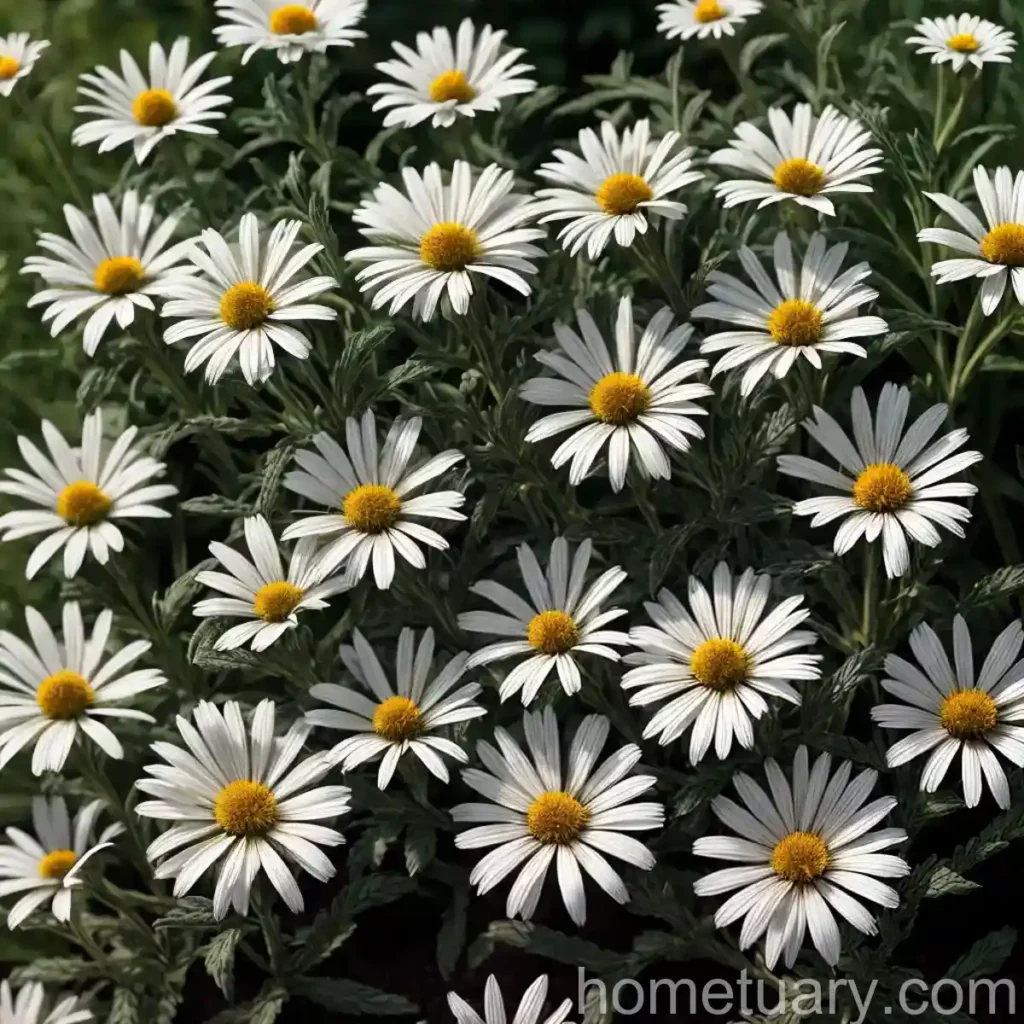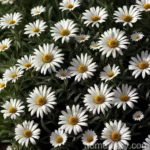Shasta Daisy (Leucanthemum x superbum ‘Alaska’): A Complete Guide
Introduction
Shasta daisy, also known as Leucanthemum x superbum ‘Alaska’, is a stunning flowering plant that has become a favorite in gardens and landscapes around the world. As a plant scientist with a passion for understanding and cultivating beautiful flora, I am thrilled to share this comprehensive guide on Shasta daisies. In this article, we will delve into the culture, uses, care, and propagation of Shasta daisies, as well as explore common diseases, pests, and interesting facts about this remarkable plant.
What is Shasta Daisy (Leucanthemum x superbum ‘Alaska’)?
Shasta daisy (Leucanthemum x superbum) is a hybrid flower that belongs to the Asteraceae family. The ‘Alaska’ variety is particularly sought after for its large, white, and yellow-centered blooms that exude an aura of freshness and purity. This perennial plant is characterized by its clumping growth habit and its ability to thrive in a variety of environments.
Key Takeaways
Before we dive deeper into the specifics of Shasta daisy care and cultivation, let’s briefly explore the key takeaways associated with this delightful plant:
- Scientific Name: Leucanthemum x superbum ‘Alaska’
- Common Name: Shasta Daisy
- Blooms: Large, white petals with yellow centers
- Growth Habit: Clumping perennial
- Adaptability: Versatile and resilient
- Attributes: Fresh, pure, and elegant
Now, let’s explore the various aspects of growing and caring for Shasta daisies in detail.
Culture
Uses
Shasta daisies are incredibly versatile and can be used in a multitude of ways, making them a valuable addition to any garden or landscape. Here are some common uses of Shasta daisies:
- Ornamental Purposes: They serve as stunning ornamental flowers, adding a touch of elegance and charm to gardens and flower arrangements.
- Cut Flowers: Their long stems and enduring blooms make them perfect for creating beautiful floral arrangements and bouquets.
- Pollinator Attraction: Shasta daisies are excellent for attracting pollinators such as bees and butterflies, contributing to the overall health of the garden ecosystem.
Water
Proper watering is essential for the health and vitality of Shasta daisies. Here are some important considerations regarding their water requirements:
- Regular Watering: While Shasta daisies are relatively drought-tolerant once established, they benefit from consistent watering, especially during dry spells.
- Well-Drained Soil: It is crucial to ensure that the soil is well-drained to prevent waterlogging, which can lead to root rot and other issues.
- Avoid Overwatering: Overly wet conditions can be detrimental to the plant, so it’s important to strike a balance and not overwater.
Sunlight
Sunlight plays a critical role in the growth and blooming of Shasta daisies. Consider the following when determining their sunlight needs:
- Full Sun: Shasta daisies thrive in full sun, requiring at least 6-8 hours of direct sunlight per day to achieve optimal growth and prolific flowering.
- Partial Shade: While they prefer full sun, Shasta daisies can tolerate some light shade, especially in regions with intense summer heat.
Fertilizer
Appropriate fertilization can enhance the growth and bloom production of Shasta daisies. Here’s what you need to know about fertilizing these lovely perennials:
- Balanced Fertilizer: Use a balanced, all-purpose fertilizer in spring, following the package instructions for application rates.
- Avoid Excessive Nitrogen: Refrain from excessive use of high-nitrogen fertilizers, as this can promote lush foliage at the expense of flowering.
Soil
The right soil conditions are crucial for the overall health and vigor of Shasta daisies. Consider the following soil requirements when planting and caring for them:
- Well-Drained Soil: Shasta daisies prefer well-drained soil to prevent waterlogging, which can lead to root rot and other issues.
- pH Level: They thrive in slightly acidic to neutral soil with a pH range of 6.0-7.5.
- Soil Amendments: Incorporating organic matter such as compost into the soil can improve its structure and fertility, benefiting the growth of Shasta daisies.
Pruning
Pruning is an essential aspect of Shasta daisy care, contributing to plant health, shape maintenance, and enhanced blooming. Follow these tips for effective pruning:
- Deadheading: Regularly remove spent blooms to encourage continuous flowering and prevent self-seeding.
- Cutting Back: After the initial bloom period, cutting back the plant by about one-third can promote a second flush of flowers.
- Spring Pruning: In early spring, prune back the old stems to encourage new growth and ensure a tidy appearance.
Propagation
Propagation methods allow gardeners to multiply their Shasta daisy plants, whether for expanding their garden or sharing with others. Here are some common propagation techniques for Shasta daisies:
- Division: Divide mature clumps of Shasta daisies every 3-4 years in early spring or fall to create new plants.
- Root Division: Use a sharp, sterile knife to divide the root ball into sections, ensuring each division has healthy roots and shoots.
- Seed Propagation: While Shasta daisies can be grown from seed, it’s important to note that they may not come true to the parent plant and could exhibit variations in flower color and form.
Container Popularity
Shasta daisies are well-suited for container cultivation, adding brightness and elegance to outdoor spaces. Their popularity in containers is attributed to the following factors:
- Compact Growth: Their clumping habit and moderate size make them ideal for container planting, whether alone or in combination with other plants.
- Portability: Containers allow for easy movement of Shasta daisies, enabling placement in the most favorable sunlight and aesthetics.
- Decorative Value: The stunning blooms of Shasta daisies make them a delightful addition to patios, decks, and balconies, enhancing visual appeal.
Container Common Diseases
| Disease | Symptoms | Treatment |
|---|---|---|
| Powdery Mildew | White powdery patches on leaves and stems | Remove affected foliage, improve air circulation, apply fungicidal spray |
| Leaf Spot | Dark spots on foliage, often with yellow halos | Prune affected leaves, water at the base to avoid wetting foliage, apply fungicidal spray as needed |
Disease Diagnosis
Diagnosing and addressing diseases promptly is crucial for maintaining the health and vigor of Shasta daisies. Common diseases that may affect Shasta daisies include:
- Powdery Mildew: This fungal disease manifests as white, powdery patches on the leaves and stems, typically in humid conditions.
- Leaf Spot: Characterized by the development of dark spots on the foliage, often accompanied by yellow halos, which can weaken the plant if left untreated.
Common Pests
Shasta daisies are generally resistant to most pests, but they can occasionally encounter the following insect adversaries:
- Aphids: These small, sap-sucking insects can distort new growth and cause foliage to become sticky with honeydew.
- Thrips: Thrips feed on flower buds and can cause them to become distorted or fail to fully open, affecting the aesthetic appeal of the blooms.
Botanist’s Tips
As a plant scientist dedicated to unraveling the intricacies of beautiful flora, here are some key tips for cultivating and appreciating Shasta daisies:
- Companion Planting: Pair Shasta daisies with complementary plants such as lavender, salvia, or ornamental grasses to create visually appealing and ecologically beneficial garden compositions.
- Naturalizing: Allow Shasta daisies to naturalize in suitable areas, creating delightful drifts of blooms that evoke a sense of natural beauty and abundance.
- Wildlife Attraction: Embrace the role of Shasta daisies in attracting beneficial insects and wildlife to your garden, contributing to a thriving and balanced ecosystem.
Fun Facts
As we journey through the world of Shasta daisies, here are some delightful and intriguing facts about these beloved flowers:
- Heritage: Shasta daisies are a result of complex hybridization involving several daisy species, leading to their distinct appearance and characteristics.
- Symbolism: Beyond their ornamental value, Shasta daisies symbolize purity, innocence, and simplicity, making them a meaningful addition to various occasions and celebrations.
- Cultural Significance: These delightful blooms have been featured in literature, art, and folklore, embodying enduring themes of beauty and resilience.
Links to External Resources
For further exploration and in-depth information on Shasta daisies, consider delving into these valuable external resources:
- The American Daisy Society – A dedicated resource for enthusiasts of daisy varieties, including Shasta daisies.
- Royal Horticultural Society – An authoritative source for horticultural guidance, plant profiles, and gardening advice.
In conclusion, Shasta daisies stand as timeless symbols of grace and elegance, captivating enthusiasts and gardeners with their enduring beauty. Embracing the nuances of their culture, care, and unique attributes can lead to a deeper appreciation of these delightful blooms, enriching our connection to the natural world and the art of gardening. Whether adorning a garden bed, gracing a container, or adorning a vase, Shasta daisies continue to enchant and inspire with their pristine allure.
Thank you for joining me on this journey through the enchanting world of Shasta daisies. May these beloved blooms bring joy and harmony to your garden and beyond.
Disclaimer: The information provided in this article is for educational and informational purposes only. It is essential to consult local gardening experts and resources for specific guidance tailored to your unique growing conditions and environment.
Keywords: Shasta daisy growing tips, Leucanthemum x superbum ‘Alaska’ care guide, How to plant Shasta daisies, Shasta daisy varieties, Leucanthemum x superbum ‘Alaska’ characteristics, Shasta daisy pruning techniques, Best soil for Shasta daisies, Shasta daisy companion plants, Leucanthemum x superbum ‘Alaska’ propagation methods, Shasta daisy watering requirements, Common pests and diseases of Shasta daisies, Shasta daisy flower meaning and symbolism, Leucanthemum x superbum ‘Alaska’ planting guide, Shasta daisy sunlight needs, Shasta daisy container gardening, Leucanthemum x superbum ‘Alaska’ landscape uses, Shasta daisy division techniques, Shasta daisy flowering season, Leucanthemum x superbum ‘Alaska’ hardiness zone, Tips for attracting pollinators to Shasta daisies, Shasta daisy cutting and arranging for bouquets, Shasta daisy natural habitat, Shasta daisy fertilizer requirements, Shasta daisies for low-maintenance gardens, Leucanthemum x superbum ‘Alaska’ disease-resistant traits, Shasta daisy common problems and solutions, Best time to plant Shasta daisies, Shasta daisy winter care tips, Leucanthemum x superbum ‘Alaska’ height and spread, Shasta daisy as a ground cover, Shasta daisy companion flowers for a colorful garden, Leucanthemum x superbum ‘Alaska’ pruning season, Shasta daisy pest control methods, Shasta daisy leaf spot prevention, Leucanthemum x superbum ‘Alaska’ vibrant bloom colors, Shasta daisy naturalizing tips, Best USDA zones for growing Shasta daisies, Shasta daisy water-wise gardening, Leucanthemum x superbum ‘Alaska’ wildlife attraction, Shasta daisy transplanting techniques, Shasta daisy foliage characteristics, Leucanthemum x superbum ‘Alaska’ soil pH preferences, Shasta daisy overwintering methods, Shasta daisy flower arrangements for special occasions, Leucanthemum x superbum ‘Alaska’ drought-tolerant features, Shasta daisy fragrance and scent, Shasta daisy as a cut flower, Leucanthemum x superbum ‘Alaska’ mature plant size, Shasta daisy for full sun locations, Shasta daisy natural pollinators and beneficial insects.
End of Article















